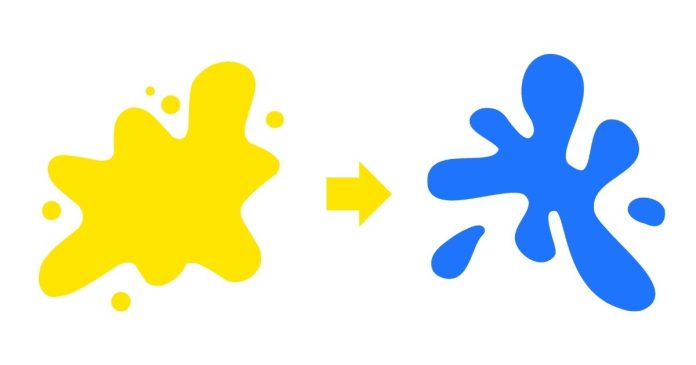At first glance, it may seem impossible to turn yellow into blue. These are two distinct colors on the color spectrum—yellow is often associated with lightness and brightness, while blue is deeper and cooler. But if we approach the task from a scientific or artistic perspective, there are several ways to manipulate color and achieve a shift from yellow to blue, whether through the use of color theory, pigments, or digital tools.
1. Understanding Color Theory
Color is a phenomenon created by light, and it is perceived by our eyes when light reflects off objects. When discussing how to change yellow to blue, we need to understand how colors interact.
- Primary Colors: Yellow is a primary color in the subtractive color model (which is used in painting and mixing pigments). The primary colors of the subtractive model are red, yellow, and blue. Each primary color cannot be created by mixing others, but they can combine to form other colors.
- Complementary Colors: Blue and yellow are not complementary colors in the traditional sense. The complementary color of yellow is purple, while the complementary color of blue is orange. However, in the additive color model (which relates to light), blending yellow with blue creates a balanced or neutral light. In a subtractive model (used for pigments), mixing yellow and blue results in green.
In theory, you can’t directly “turn” yellow into blue because the two colors are quite different on the color wheel. But understanding how colors relate helps guide us on how to achieve an effect that mimics this transformation.
2. Using Paint and Pigments
If you’re working with physical media like paint, transforming yellow to blue is quite challenging since mixing these two colors directly will typically give you green or brown, not blue. However, artists can take certain approaches to simulate this shift.
- Layering Techniques: One method is layering. You can start with yellow and gradually apply blue pigments on top to create depth and complexity. While you won’t “turn” yellow into blue, this technique can create a sense of transition.
- Complementary Mixing: Artists can use the complementary color of yellow (purple) as a neutralizing tool. By carefully mixing purple with yellow, they can create more subdued or grayish hues, which may be modified further to evoke a cooler or blue-like tone, even though they won’t be pure blue.
- Blue-Tinted Overlays: If you want yellow areas to appear blue, you can apply a translucent blue glaze over the yellow. This doesn’t “turn” yellow into blue but creates the illusion of blue by allowing the underlying yellow to affect the final appearance. A thin blue film can change the perception of the yellow beneath it.
3. Digital Manipulation
In digital art and photography, turning yellow into blue is relatively simple, thanks to advanced tools that manipulate pixels.
- Hue Shifting: Software like Photoshop allows for precise color manipulation. A technique called “hue shifting” can change yellow into blue by rotating the color wheel. This process involves adjusting the hue slider in a way that transforms the color data in the image.
- Selective Color Adjustment: You can also selectively adjust the yellow areas of an image by isolating those colors and shifting them towards blue. Digital color grading software lets you manipulate RGB (Red, Green, Blue) values individually to change how the yellow areas are perceived.
- Channel Mixing: By adjusting the RGB channels in more advanced digital manipulation software, it is possible to swap out the yellow channel with blue tones, resulting in a color transformation from yellow to blue.
4. Mixing Lights (Additive Color Mixing)
When working with light rather than pigment, such as in digital displays or stage lighting, the process changes drastically. The additive color model involves mixing light of different colors to create new colors.
- Adding Blue Light to Yellow Light: In the context of light, yellow is made by mixing red and green light. If you add blue light to yellow, you would get white light, as red, green, and blue light together create white. However, if the goal is to emphasize blue in a yellow light environment, adjusting the light sources or using blue filters can achieve the desired effect.
5. Chemical and Material Effects
In the realm of chemistry and material science, turning yellow into blue would typically require changing the molecular structure of the substance, which would alter the way light interacts with it.
- Dyeing and Pigment Transformation: Some dyes and pigments can change color depending on external factors like temperature or pH. Certain chemical processes or treatments may be able to change a yellow substance into a different color, including blue. For example, changing the pH of a solution with yellow dyes could shift the appearance toward a blue or greenish hue, though this isn’t a typical or direct method.
- Metallurgy and Ceramics: Some metals or ceramic glazes change color at certain temperatures, often transitioning from yellowish tones to blue. These are highly specific processes and rely on the interaction between the material and heat.
Conclusion
While it may not be possible to directly “turn” yellow into blue in the most literal sense, various techniques in art, digital tools, and science allow for manipulation of yellow toward a blue appearance. Whether through layering pigments, shifting digital hues, or mixing light, the ability to transition between colors—while remaining true to the underlying theory—can achieve remarkable transformations. Understanding the context, whether it’s artistic, digital, or chemical, is key to making this shift successfully.



